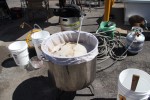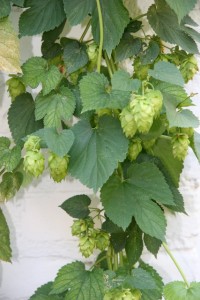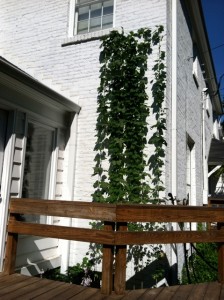Spring is coming to Louisville. How do we know this to be true? One of the early vestiges of spring … the hops have sprung. The vines that will support the buds that will bring our beer bitter character and floral delight are starting to make their way out of the ground and reach ever upward to catch the warming sun.
My hops poked out a little and thanks to a curious squirrel’s search for nuts, several sprouts were visible Easter morning. Alleluia. Paul at My Old Kentucky Homebrew announced that his hop rhizome shipment is in as of Monday. Amen. It is a glorious time.
Kentucky has pretty fair climate for growing hops and as a homebrewer, you really should make them part of your garden. You won’t need much yard space, but you do need space for them to climb. And I mean climb. Once they get going these vines will take off. On a warm day after a rain, I have seen them grow 4-6 inches in a day.
I found a nice three foot by three foot space for the plant and let them grow up the side of my house to the second floor window, about fifteen feet. This area gets excellent morning sun and in July still has sun until about 2 pm. They could probably stand a bit more sun, but this has produced a good number of cones for two years and I don’t think I can move the house.
Five concrete nails support the twine, which is anchored in the ground about three away feet from the house. It is best that the leaves don’t press up against the wall and it is even better if they can get sun on both sides. You will get a number of sprouts from one plant. Select 3-4 healthy shoots that are 10 inches long (used a ruler). Prune the other vines and place the survivors on the twine. They will twist their way up.
You will probably have to continue clipping new shoots for a while, but they finally give up and bend to your will as an urban farmer. Note: Mother Nature never bends to your will; she just lets you think you are in charge for a while.
Hops are easy to tend. Add a little organic fertilizer each month. Rain or watering two or three times a week and a little mulch will keep the roots from drying out. But they do want good drainage, or as my dad says, “they don’t like their feet wet”. They will take off in March, and you will get a bucket load of hops from each plant in early September.
Hops are grown from rhizomes, which you can find at My Old Kentucky Homebrew or most homebrew websites. It is the perfect time to get them in the ground. You should get a reasonable crop this year, but most people will tell you it takes three years to get a full harvest. Check out My Old Kentucky Homebrew for complete planting instructions or Northernbrewer.
But of course the real reason for growing hops is to impress your friends and neighbors. Nothing says you are a serious beer maker or drinker like growing your own hops. When people ask if you make, drink or enjoy beer, your answer is now, “Well, I grow my own hops.” Impressive!
At your next summer party, guests will politely comment on your nice tomato plants and the lovely roses. Then you wander over and show them your hops stretching to the sky. They will acknowledge you as the super agrarian master of all time and beer space that you are. Hoppy.







